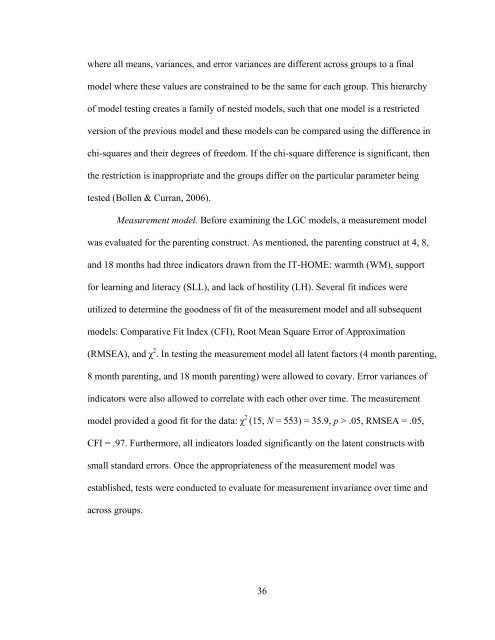DIFFERENCES BETWEEN ADOLESCENT AND ADULT MOTHERS ...
DIFFERENCES BETWEEN ADOLESCENT AND ADULT MOTHERS ...
DIFFERENCES BETWEEN ADOLESCENT AND ADULT MOTHERS ...
You also want an ePaper? Increase the reach of your titles
YUMPU automatically turns print PDFs into web optimized ePapers that Google loves.
where all means, variances, and error variances are different across groups to a final<br />
model where these values are constrained to be the same for each group. This hierarchy<br />
of model testing creates a family of nested models, such that one model is a restricted<br />
version of the previous model and these models can be compared using the difference in<br />
chi-squares and their degrees of freedom. If the chi-square difference is significant, then<br />
the restriction is inappropriate and the groups differ on the particular parameter being<br />
tested (Bollen & Curran, 2006).<br />
Measurement model. Before examining the LGC models, a measurement model<br />
was evaluated for the parenting construct. As mentioned, the parenting construct at 4, 8,<br />
and 18 months had three indicators drawn from the IT-HOME: warmth (WM), support<br />
for learning and literacy (SLL), and lack of hostility (LH). Several fit indices were<br />
utilized to determine the goodness of fit of the measurement model and all subsequent<br />
models: Comparative Fit Index (CFI), Root Mean Square Error of Approximation<br />
(RMSEA), and χ 2 . In testing the measurement model all latent factors (4 month parenting,<br />
8 month parenting, and 18 month parenting) were allowed to covary. Error variances of<br />
indicators were also allowed to correlate with each other over time. The measurement<br />
model provided a good fit for the data: χ 2 (15, N = 553) = 35.9, p > .05, RMSEA = .05,<br />
CFI = .97. Furthermore, all indicators loaded significantly on the latent constructs with<br />
small standard errors. Once the appropriateness of the measurement model was<br />
established, tests were conducted to evaluate for measurement invariance over time and<br />
across groups.<br />
36
















